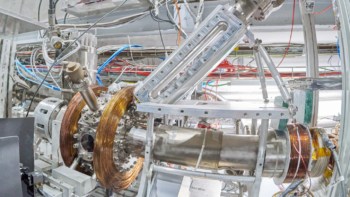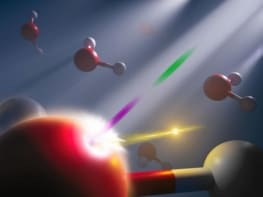Maxwell's Demon: Why Warmth Disperses and Time Passes
Hans Christian von Baeyer
1998 Random House 256pp $25.00hb
It was in 1867, in a letter to his friend and colleague Peter Tait, that James Clerk Maxwell first stated his renowned “demon paradox”. He imagined a vessel with two compartments, separated by a controllable door, with a demon that allowed hot molecules to accumulate on one side, and cold molecules on the other. The resulting temperature difference could then be used to drive a thermal engine. Thus, the demon could convert the thermal energy of molecules at equilibrium into useful work and violate the second law of thermodynamics. It is remarkable testimony to Maxwell’s insight that this question – raised at a time when molecules were still a conceptual crutch and poorly characterized – took us over a century to resolve. Only within recent years have we been able to show that it is impossible to sort molecules without expending more energy than the work that can be extracted from the sorted molecules. The second law of thermodynamics does indeed hold true.
In this book, Hans Christian von Baeyer reviews the history of that clarification, and uses it as a basis for recounting much of the content and history of thermodynamics and statistical mechanics. It is a superb account, exhibiting the expository skills the author demonstrated in earlier books and revealing his sound understanding of the subject. Above all, the book shows a deep sense of the rhythms and structure of science. It is aimed at a broad readership, as the absence of equations makes clear. The author also omits figures, although this at times requires considerable verbal baggage, for example, when he describes the shapes of graphs. The book’s final chapter, on recent work related to motion produced by fluctuations, suffers particularly in this respect.
Nevertheless, in contrast to many other science books sold at airport bookstalls for casual reading, this one promises less and delivers more. It has about 250 slim pages, and the general reader actually has some chance of finishing it. Moreover, unlike many of its competitors, the book does not promise to solve the deep mysteries of nature, such as the origin of life or the meaning of free will.
However, the desirable brevity comes at some cost. You will not, for example, find new historical scholarship. In fact, the author acknowledges his debt to an authoritative earlier volume, Maxwell’s Demon: Entropy, Information, Computing (H S Leff and A F Rex (ed) Adam Hilger 1990), which is an annotated collection of reprints. The brevity of von Baeyer’s book also means that while there is a great deal about entropy – with Boltzmann a central figure – Josiah Willard Gibbs never appears.
Boltzmann supplied us with the microscopic understanding of entropy through his famous equation S = k logW, which appears on his tombstone, although it never actually appears in this book, except in a cumbersome verbal form. (That equation was made immemorial for me when I was a teaching assistant and found an exam script where the student had written “S = k logW, where k is Klotzmann’s constant”.) Boltzmann’s insight was elaborated by Gibbs into the more detailed set of tools that most of us who work in this subject have to use.
The history of thermodynamics in the early 19th century is a welcome reminder that the relative date of scientific developments does not always map neatly into our perception of relative difficulty. The steps toward understanding the first and second laws were interwoven in time. Yet, today, the law of conservation of energy is folklore. Entropy, except for meaningless cocktail-party patter, is a subject for specialized college courses, and even there it is not really understood by many of us until we reach statistical mechanics.
The modern resolution of the demon paradox is based on the fact that to sort molecules, we (or the demon) need to make measurements on them. Von Baeyer gives Brillouin credit for first treating the recorded results of measurements as part of the total physical system viewed in the entropy balance. Actually Leo Szilard had already taken that pioneering step. Brillouin, who made several major contributions to physics, unfortunately only added confusion to our understanding of the demon. Enlarging on Szilard’s early work, we eventually learned that the critical energy dissipation, which saves the second law, occurs when the recorded measurement information is erased and the memory is reset for its next (or first) use. This contrasts with our earlier view that energy is expended only when information is transferred from the molecule to the register that controls the shutter or other sorting device.
In the two concluding chapters von Baeyer makes contact with the forefront of recent research, and this is the weakest part of what is otherwise an excellent book. In the first of these two chapters we meet “algorithmic entropy” and its relationship to real physical entropy. Algorithmic entropy is the minimum number of bits needed to specify a number or structure. According to this view, a periodic array of molecules is easily described, but random placement requires us to give the position of every molecule. However, in a book that emphasizes history I was surprised that we do not learn that it was Charles Bennett, my colleague at IBM, who made the first step in connecting physical entropy to earlier, more mathematical notions about the definition of randomness. While Boltzmann and Gibbs taught us that entropy characterizes ensembles, not a particular molecular configuration, Bennett told us that, in fact, entropy can be assigned to each particular configuration, and then can be averaged over the ensemble.
The last chapter deals with recent work on “thermal ratchets” – systems in which particles are in time-dependent and spatially periodic force fields and also subject to noise. Neither the force field nor the noise exert a net force, but the particles can be moved by the interaction of the two. Again the account is blemished by singling out one name, Dean Astumian, in a field that has a very complex history. Thermal ratchets are supposedly found in biological systems, but that case is far from proven.
These last two chapters illustrate the whims of fashion. The fact that entropy is not just a property of an ensemble is a deep insight, and one that came only after many decades of supposedly deep analyses of entropy. However, this point has attracted surprisingly little attention among practitioners of statistical mechanics. In contrast, thermal ratchets have become a busy little industry, the depth and significance of which may be transitory.
In fact, labels may have a great deal to do with the level of attention given to topics. If Maxwell’s demon had been called Maxwell’s sorting device, would this book have ever been written?



